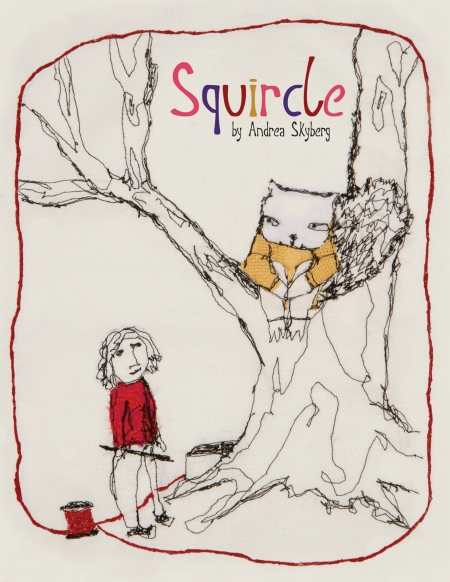Squircle
“Squircle” is a such a delightfully silly word that children will love simply to hear it and repeat it. Author and artist Andrea Skyberg offers this and a few more smiles in her new children’s picture book by the same name. A story about interconnectedness and dealing with fear, anger, and other negative emotions, Squircle follows a young girl named Evie as she heads off on a small adventure, encountering helpful forest creatures along the way. Each animal offers thoughtful and calming advice, and Evie eventually realizes how connected she is with them all. The book’s positive message of living in the moment—accepting life as it comes and others as they are—is an encouraging one. The thread of connection from one being to the next comes to life visually through a ball of red twine that Evie carries.
The book features two very different styles of artwork, and it is this artwork that clearly shines in Squircle. The illustrations that accompany most of the text, following Evie as she wanders on her way, are simple and evocative. A double-page illustration of the girl encountering a deer is especially appealing in the emotion it conveys. At five different times over the course of the story, Evie voices a concern, and each time, a different animal answers. Readers turning the page for each creature’s reply find an illustration quite unlike the other quiet drawings; these pages instead display elaborate and rather quirky large pictures of Evie, one with each specific animal. These five illustrations are collaged photographs of fabric murals, constructed in appliqué, quilting, and embroidery, created by Skyberg in collaboration with schoolchildren in her home state of Wisconsin. Bright and highly unusual, they are extraordinarily colorful and detailed. Although some of the faces in the murals may frighten the youngest and more timid among the book’s audience, most children will enjoy this uncommon fiber artwork.
Squircle reflects Skyberg’s passion for understanding and promoting the connections that exist among all living creatures. Evie’s story is meant to show how she is connected to the world around her, and how recognizing that interconnectedness helps her learn to live in the moment, with greater tolerance and less anger and fear. Skyberg herself connects with schoolchildren through art. Those students in turn connect pieces of fabric to contribute to the murals that then connect back to Evie’s story, both embodying and illustrating the threads that tie one and all together. Even if Skyberg’s message and her talk of the “tapestry of life” feels oddly reminiscent of a commercial for cotton, “the fabric of our lives,” there is a time-honored, valid truth to the existence and benefits of such connections. Skyberg’s interpretations may be more literal than most, but few will quarrel with how effectively she conveys her message.
Reviewed by
Cheryl Hibbard
Disclosure: This article is not an endorsement, but a review. The publisher of this book provided free copies of the book and paid a small fee to have their book reviewed by a professional reviewer. Foreword Reviews and Clarion Reviews make no guarantee that the publisher will receive a positive review. Foreword Magazine, Inc. is disclosing this in accordance with the Federal Trade Commission’s 16 CFR, Part 255.

